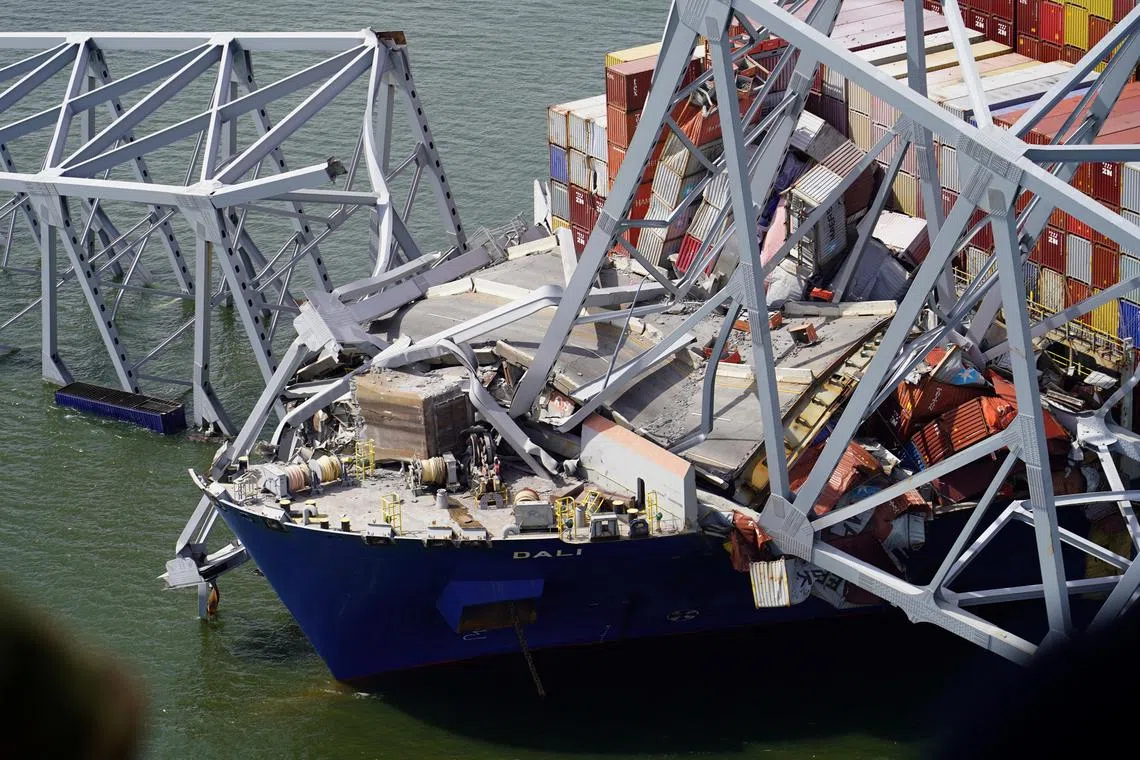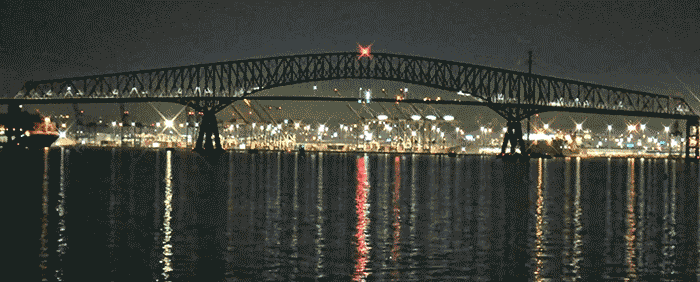ST Explains: Baltimore bridge collapse
What could cause large vessels to lose power?
Sign up now: Get ST's newsletters delivered to your inbox

Although the vessel had reportedly dropped its anchors, it was unable to come to a stop in time and crashed into the bridge.
PHOTO: REUTERS
Follow topic:
SINGAPORE – On March 26, a Singapore-flagged vessel, Dali, crashed into a bridge in Baltimore in the United States, after the crew lost control of the ship following its loss of propulsion.
This meant that it was no longer being propelled forward by engine power.
Although the vessel, which was being piloted, had reportedly dropped its anchors as part of its emergency procedures, it was unable to come to a stop in time and crashed into the bridge.
This was due to the momentum from its initial course of travel, said Dr Kenneth Low, an associate professor and engineering cluster director at the Singapore Institute of Technology.
The Straits Times looks at the role of pilots as vessels manoeuvre port waters, possible reasons the Dali lost power, and what ship crews do during such emergencies.
1. What are ship pilots, and why are they needed?
The International Maritime Organisation recommends that foreign-flagged vessels hire local qualified pilots to guide their ships in and out of ports, as well as in other areas where specialised local knowledge is required.
Ships engaged in foreign trade calling at ports in Maryland, the state of the city of Baltimore, must hire a local ship handling specialist, known as a pilot, to be on board to navigate the vessel safely into port, said the Association of Maryland Pilots on its website.
Roger (not his real name), a navigational officer at a major shipping company with three years of experience in navigating a container ship, said such pilots function as “local guides” for the ship’s captain to sail through ports.
Typically, local pilots do not take over the steering of a ship, as this responsibility still falls on the captain and ship crew, added Roger.
Jon (not his real name), who was a captain with about 14 years of sailing experience at an established shipping company, said that pilots normally play advisory roles and provide “very precise” navigational instructions to captains.
Like Roger, he spoke to ST on condition of anonymity. Both are Singaporeans.
As the local pilots are familiar with the waters, they usually tell captains to travel at certain speeds at various points of the journey in and out of ports and to turn the helm – the ship’s steering wheel – at certain degrees to travel in exact directions, Jon said.
In Singapore, vessels with a capacity of 300 gross tons and above, as well as liquefied petroleum gas, liquefied natural gas, chemical tankers and passenger vessels, must engage a local pilot in order to ensure safe navigation when entering or exiting the port.

2. What could cause vessels to lose power temporarily?
Roger said a vessel’s temporary loss of power is typically caused by switchboard issues or a failure in its main power generation system.
The ship captain would not be able to steer the ship by moving the helm, as it is operated by a hydraulic system that requires electricity, said Dr Low.
Ships need power to reverse the flow of travel, he explained. Due to momentum, a moving ship that loses power would need to travel for a longer distance than a powered ship before coming to a stop after anchors are put down.
There are several common causes of a vessel’s electrical power generation system failure, said Mr Chong Kee Sen, emeritus president of the Institution of Engineers, Singapore.
These include a short circuit, damage to an electric transmission line, overloading in the vessel’s electrical distribution system, and failure of mechanical parts in the electrical generation system, said Mr Chong, who specialises in major industrial development projects including marine facilities.
3. Are accidents like the Dali’s common?
It is “highly unusual” for ocean-going vessels to lose power, said Dr Low.
This is because large container liners, including the one involved in the accident in Baltimore, are considered to be some of the more advanced vessels in the world, he added. They adhere to strict design, building and maintenance standards, and are usually installed with complex equipment health monitoring systems.
He said such ships may, very rarely, experience blackouts during foul weather conditions in the deep seas, but it is very unusual for them to lose power while cruising in calm waters.
Roger said that it is “very exceptional” for a ship to lose power like this, adding that the occurrence of crashes of this severity – with multiple civilian casualties – is not common.
Jon added that an emergency generator would have normally kicked in within 45 seconds, allowing the crew to steer the vessel to a safer position in most cases.
Roger said ships also need to navigate around large structures, like bridges, “all the time”, even though Singapore’s port does not have such structures.
Jon concurred, saying that passing under bridges is very common worldwide, especially for ports in America and Japan.
Dr Low said no bridges are designed to withstand the direct impact of such a large container ship, and the design of the Francis Scott Key Bridge could not be considered a contributing factor in this accident.
4. What is the standard operating procedure during such emergencies?
The standard operating procedures usually include dropping the ship’s anchors and issuing a call warning to the authorities and nearby ships, if applicable.
Jon noted that the crew appeared to have followed the emergency procedures quickly, by issuing a mayday call warning to inform the authorities of an impending crash.
However, a 300m ship like the Dali could take six to eight minutes after dropping anchor to come to a complete stop, Roger said.
5. How often do vessels undergo maintenance checks?
Both Roger and Jon said ships follow strict inspection regimes, especially Singapore-flagged ones bound by the laws of Singapore where the ship is registered.
The ship involved in the Baltimore crash had passed two foreign port state inspections
Jon said that vessels under international companies would go through a thorough check on a weekly or monthly basis, depending on the type of equipment. All emergency equipment would also need to be in working condition to pass safety requirements stipulated by company regulations.

